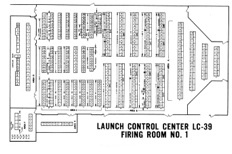History of the Firing Rooms
Firing Room 1
Firing Room 1 was the first of the rooms to be equipped. It supported the launch facilities integration and testing process with AS-500F in the Spring and Summer of 1966. It was the first of the Firing Rooms to support a mission in the Apollo era, with the launch of the unmanned Saturn V known as AS-501 (Apollo 4) on November 9, 1967. It went on to control the launches of Apollos 8, 9, 11, 13, 15, 16, and 17.
Firing Room 1 supported the first launch of the Space Shuttle, with Columbia’s maiden flight on April 12, 1981. Firing Room 1 was named the “Young-Crippen Firing Room” in 2006, honoring the crew of STS-1. Firing Room 1 was refit to support the Ares program, and supported the launch of Ares I-X on October 27, 2009. It went through a further redesign and was fitted out with new equipment and computers in 2011 to support future manned space initiatives.
Firing Room 2
Firing Room 2 was the second Firing Room brought up to operational capability. It first saw action for the second unmanned launch of a Saturn V, Apollo 6, on April 4, 1968. Firing Room 2 was used for the launches of Apollo 9, 12, and 14, and the final Saturn V launch, the Skylab Orbital Workshop, on May 14, 1973.
During much of the Space Shuttle era, Firing Room 2 was used for launch sequencer software development and testing. It is interesting that in a 2011 podcast, NASA noted that “Shuttle launches require two active firing rooms: one as the primary and one with senior engineering and management personnel teams. A third firing room is capable of stepping in.”
Firing Room 3
Firing Room 3 was first used for the launch of Apollo 10. General Electric was given a contract in November 1971 to modify the Firing Room and associated support systems for the Skylab program. Firing Room 3 controlled the final four missions that used Apollo technology: Skylab 2, 3, and 4, and the Apollo-Soyuz Test Project. All four of these missions used the Saturn IB rather than the Saturn V launch vehicle. Because there were fewer vehicle stages on the Saturn IB, the control equipment for the S-IB first stage occupied the consoles that were normally used for the S-II stage of the Saturn V.
Firing Room 3 was briefly used as a stop on KSC bus tours in the mid- to late 1970’s. Visitors could watch a compressed replay of the events leading up to the launch of Apollo 11 from the Visitors Gallery. (See this page of this website for a photo of Firing Room 3 during a tour.)
Firing Room 3 became one of the primary Firing Rooms for controlling Space Shuttle launches. By 1993, Firing Room 1 and Firing Room 3 were the two “active” Firing Rooms.
Firing Room 4
Firing Room 4 was the come-from-behind story of the Launch Control Center. It was never fully built out during the Apollo era. As can be seen in the photo gallery below, it was used to display massive PERT charts and schedules during the construction of Launch Complex 39 and the integration of Apollo/Saturn systems. It was used for meetings with contractors support teams. The photos of contractor teams at the bottom of this page were taken in Firing Room 4 after the ASTP launch.
The Firing Room continued to be primarily a support area during the early and middle years of the Shuttle program. As described in an October 1993 KSC website update, Firing Room 4 was “only a partial firing room and is primarily used as an engineering analysis and support area for launch and checkout operations.”
Firing Room 4 finally got its place in the spotlight in 2006. It underwent extensive renovations beginning in 2004. It launched the final 15 missions of the Space Shuttle beginning with STS-121 on July 4, 2006, and concluding with STS-135 on July 8, 2011.
The KSC press release for the reopening of Firing Room 4 in 2006 noted that “on launch day, a firing room is packed with upwards of 216 engineers at computer consoles.” Computerization of the launch sequence activities reduced the number of people needed in the Firing Room to support a launch from the Apollo days, when the Firing Room held over 440 people.
The KSC Public Affairs Office has an interactive website which gives a simplified overview of what it was like to be on a Space Shuttle launch team.
The photos below show the Firing Rooms in use and illustrate how they evolved over the years.


